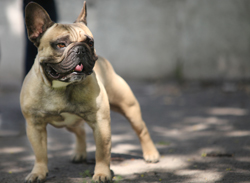French Bulldogs are small, muscular dogs with soft and loose skin that forms wrinkles, especially on the head and shoulders. Their coat is fawn, white, brindle, or brindle and white, and is fine, short, and smooth. These dogs have dark eyes, a short face, and are known for their "bat" ears. French Bulldogs measure 11 to 12 inches at the shoulder and weigh 28 pounds or less.
These dogs tend to be a bit clownish, and they enjoy entertaining their human family members with their silly tricks and games.
These dogs make great companion animals and are adaptable to any home environment. They thrive in apartments and urban surroundings, provided they have air conditioning and are taken for regular walks. French Bulldogs are active, alert, affectionate, and fun-loving dogs.
French Bulldogs are very popular with celebrities. Actor Leonardo DiCaprio and ex-girlfriend Gisele Bündchen share custody of one of these dogs, and Martha Stewart's little Frenchies have their own blog.
French Bulldogs are indoor dogs and are adaptable, well behaved, and affectionate. They are also very playful and active, without being overly boisterous. These dogs make excellent watchdogs, but their primary role is that of a companion animal or lap dog.
These dogs tend to be a bit clownish, and they enjoy entertaining their human family members with their silly tricks and games. They also like to cuddle and relax with their favorite person. French Bulldogs are sweet and amiable and get along great with nearly everyone. They make great apartment dogs due to their small size and friendly personalities, but they will bark ferociously if an unfamiliar person visits their home.
Although these dogs have minimal exercise requirements, they do enjoy some outdoor fun. However, they cannot handle the heat and should not spend time outdoors in hot or humid weather. Short walks in the mornings and evenings provide plenty of exercise for these small dogs.
French Bulldogs are known to suffer from numerous health conditions that may negatively affect length or quality of life. Stenotic nares, congenital hip dysplasia, patellar luxation, elongated soft palate, hemivertebrae, intervertebral disc degeneration, intestinal malabsorption disorders, and deafness are all known to affect this breed. These dogs are also prone to several eye conditions, including entropion, distichiasis, and cataracts.
Additionally, French Bulldogs, like other flat-faced dogs, may suffer from brachycephalic airway syndrome. This condition can cause wheezing and snoring and may affect activity and breathing. These dogs are also vulnerable to heatstroke and should not spend time outdoors during hot or humid conditions. They need to be in cool temperatures, and should only live in homes with air-conditioning.
French Bulldogs generally live 9 to 11 years, provided they receive routine veterinary care and timely vaccinations, are fed a healthy diet with an attention to weight management, and are kept inside during the summer.
Naturally stubborn, French Bulldogs aren't the easiest dogs to train. They are also difficult to housetrain. They do respond fairly well to positive reinforcement, however, but it might take some time to find the right reward. They learn quickly and like to perform for an audience. This can be used to improve training success.
Most of the breed's behavioral problems stem from an unlimited supply of energy. Unless taken for regular walks, these dogs are prone to jumping on and off furniture, running around the house wildly, chewing on everything and anything in sight, and barking excessively. They may also dig when outdoors and hide their human family's belongings.
French Bulldogs are generally easy-going and rarely lose their cool. They get along with everyone, although slow-moving cats may suffer frequent harassment, and they don't usually snap or bite. Early socialization can help ensure healthy interaction with humans and other animals.
French Bulldogs require minimal coat care. A weekly brushing with a soft bristle brush or rubber hound glove will remove any loose hair and distribute skin oils over the coat. Additional brushing with a grooming mitt or stripping comb may be necessary during spring and fall shedding seasons.
Bathing these dogs is rarely necessary, but a quick bath once each month ensures a soft and fresh-smelling coat. These dogs have a lot of wrinkles that require regular cleaning with a damp cloth. They must be dried thoroughly after cleaning to prevent bacterial or fungal growth in the skin folds.
Nail trimming should be done every couple of weeks, and the ears should be cleaned regularly and checked weekly for signs of infection or excess wax accumulation. French Bulldogs need their teeth brushed daily to prevent gum disease and tooth decay. The addition of dental treats and drinking water additives that contain fluoride are also beneficial.
French Bulldogs originated as companion animals and they continue to be used for this purpose today. During the 19th centuries, lacemakers in England selectively bred the standard bulldog to create a "toy" breed to be used as a lapdog. When some lacemakers relocated to France during the Industrial Revolution, they brought the toy bulldogs with them. The downsized dogs quickly became a hit in France, and they were dubbed "Bouledogue Francias."
Wealthy Americans visiting France also fell in love with the breed and took the dogs to the United States. Americans began breeding the dogs and they quickly increased in number and popularity. The dogs became known as French Bulldogs. During the early 1900s, these dogs were some of the most popular show dogs in the United States.
Today, their popularity has decreased slightly, but they remain very popular as household pets. They are especially popular in urban areas among people who desire a bulldog but don't have space for a larger animal.
The American Kennel Club officially recognized the French Bulldog in 1898.

